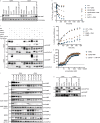The DNA-binding induced (de)AMPylation activity of a Coxiella burnetii Fic enzyme targets Histone H3
- PMID: 37932372
- PMCID: PMC10628234
- DOI: 10.1038/s42003-023-05494-7
The DNA-binding induced (de)AMPylation activity of a Coxiella burnetii Fic enzyme targets Histone H3
Abstract
The intracellular bacterial pathogen Coxiella burnetii evades the host response by secreting effector proteins that aid in establishing a replication-friendly niche. Bacterial filamentation induced by cyclic AMP (Fic) enzymes can act as effectors by covalently modifying target proteins with the posttranslational AMPylation by transferring adenosine monophosphate (AMP) from adenosine triphosphate (ATP) to a hydroxyl-containing side chain. Here we identify the gene product of C. burnetii CBU_0822, termed C. burnetii Fic 2 (CbFic2), to AMPylate host cell histone H3 at serine 10 and serine 28. We show that CbFic2 acts as a bifunctional enzyme, both capable of AMPylation as well as deAMPylation, and is regulated by the binding of DNA via a C-terminal helix-turn-helix domain. We propose that CbFic2 performs AMPylation in its monomeric state, switching to a deAMPylating dimer upon DNA binding. This study unveils reversible histone modification by a specific enzyme of a pathogenic bacterium.
© 2023. The Author(s).
Conflict of interest statement
The authors declare no competing interests.
Figures





Similar articles
-
Revisiting AMPylation through the lens of Fic enzymes.Trends Microbiol. 2022 Apr;30(4):350-363. doi: 10.1016/j.tim.2021.08.003. Epub 2021 Sep 13. Trends Microbiol. 2022. PMID: 34531089 Review.
-
A Novel Fic (Filamentation Induced by cAMP) Protein from Clostridium difficile Reveals an Inhibitory Motif-independent Adenylylation/AMPylation Mechanism.J Biol Chem. 2016 Jun 17;291(25):13286-300. doi: 10.1074/jbc.M115.705491. Epub 2016 Apr 13. J Biol Chem. 2016. PMID: 27076635 Free PMC article.
-
Noncanonical Inhibition of mTORC1 by Coxiella burnetii Promotes Replication within a Phagolysosome-Like Vacuole.mBio. 2019 Feb 5;10(1):e02816-18. doi: 10.1128/mBio.02816-18. mBio. 2019. PMID: 30723133 Free PMC article.
-
Fic Proteins Inhibit the Activity of Topoisomerase IV by AMPylation in Diverse Bacteria.Front Microbiol. 2020 Aug 26;11:2084. doi: 10.3389/fmicb.2020.02084. eCollection 2020. Front Microbiol. 2020. PMID: 32983060 Free PMC article.
-
Bacterial FIC Proteins AMP Up Infection.Sci Signal. 2009 Mar 17;2(62):pe14. doi: 10.1126/scisignal.262pe14. Sci Signal. 2009. PMID: 19293428 Review.
Cited by
-
Virulence factor discovery identifies associations between the Fic gene family and Fap2+ fusobacteria in colorectal cancer microbiomes.mBio. 2025 Feb 5;16(2):e0373224. doi: 10.1128/mbio.03732-24. Epub 2025 Jan 14. mBio. 2025. PMID: 39807864 Free PMC article.
References
Publication types
MeSH terms
Substances
LinkOut - more resources
Full Text Sources
Molecular Biology Databases
Research Materials

